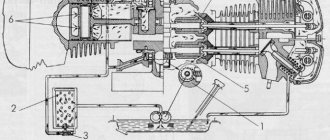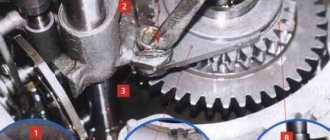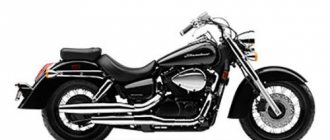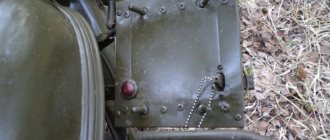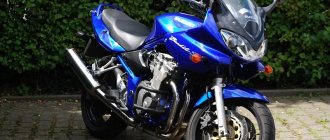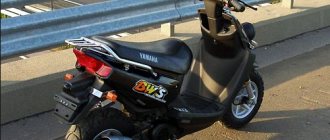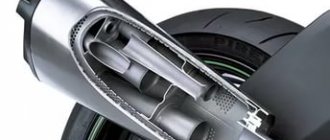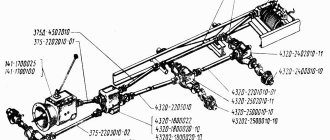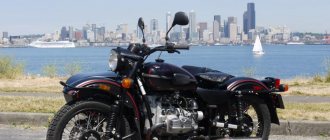Ural M-67-36 is a heavy-duty motorcycle with the ability to install a sidecar. Due to its reliability and versatility of use, this model became one of the most popular in the USSR. The first releases of the unit took place in 1976 and immediately won success in the field of motor industry. It was the M 67 36 modification that ensured the competitiveness of IMZ with foreign manufacturers.
The prefix “36” in the name of the motorcycle means the power produced by the engine. Before this, a model was produced without an additional number; it could produce 32 horsepower at 5300 rpm . Another 4 units of power were obtained by increasing the diameter of the diffuser hole.
Characteristics of the Ural M67-36 motorcycle
The only characteristics needed constantly throughout the entire operation of the vehicle. No motorcycle maintenance or repair is complete without them. It is not possible to keep all the data in memory at all times, and it is not necessary. It is advisable to always have them at hand.
Refill tanks
Fuel tank – 19 liters. Engine lubricant is poured into the crankcase of a 2.3-liter engine. Oil is poured into the gearbox housing - 1.2 liters. In the main gear - 0.110 liters. The front steering fork is filled with oil - 0.135 liters - into each feather. Oil must be poured into the air filter - 0.150 liters. In the rear shock absorber - 0.105 liters.
Adjustment data
Thermal clearance of valves on a cold engine is 0.05 mm. The breaker contact gap is 0.4–0.6 mm. The gap between the spark plug electrodes is 0.6-0.7 mm. The working gap between the brake pads and the drum is 0.3-0.7 mm. The free play of the brake and clutch steering levers is 5-8 mm. The adjustment gap of the main gear is 0.1-0.3 mm. The free travel of the foot brake pedal is ¼ of the full pedal travel. The pressure in the front wheels and the stroller is 1.5 + 0.1 kgf/cm squared. The pressure in the rear and spare wheels is 2.5 + 0.1 kgf/cm squared. The convergence of the wheel planes over the length of the motorcycle is 10-12 mm. The camber angle of the planes of the rear wheel and the stroller wheel is 1-2 degrees. Installing the headlight (motorcycle loaded): The position of the axis of the light beam of the high beam filament is horizontal. The distance between the upper boundary of the spot on the screen from the low beam filament and the projection of the center of the headlight onto the screen at a distance of 10 meters is 10 mm.
Return to contents — ↑
Current modifications
During the production of the truck in question from Ural manufacturers, several modifications were developed, the main difference between which is the power of the power plant. The following models have become the most popular:
- "Ural-4320-01" - has an improved cabin, platform and gearbox. Year of release: 1986.
- Similar modifications with a YaMZ engine with a power of 180 horses, as well as a truck with an increased wheelbase and cross-country ability.
- The performance characteristics of the Ural-4320-31 differ from its predecessor in the presence of an eight-cylinder power unit (YaMZ) with a capacity of 240 horsepower and an improved power density. The car was released in 1994.
- Model 4320-41 - YaMZ-236NE2 engine (230 hp), year of manufacture - 2002, compliance with Euro 2 standards.
- Option 4320-40 is a version of the previous car, equipped with an extended wheelbase.
- Modification 4320-44 - a cabin of improved comfort appeared (manufactured in 2009).
- Long wheelbase "Ural-4320-45".
- Variation designed for installation of special equipment (4320-48).
Motorcycle engine diagram Ural m67-36
1 - generator; 2 — camshaft; 3 - pusher; 4 — pusher guide; 5 — sealing cap; 6 — pusher rod; 7 — tube (casing) of the rod; 8 - cylinder; 9 - piston; 10 — cylinder head; 11 - valve; 12 — valve spring; 13 — adjusting bolt; 14 — rocker arm axis bracket; 15 — lock nut of the adjusting bolt; 16 — rocker arm; 17 — rocker axis; 18 — head cover; 19 — cylinder head mounting pin; 20.23 - gasket; 21 — rocker axis stand; 22 — oil drain channel from the cylinder head; 24 — cylinder drain pipe for oil; 25 — compression rings; 26 — piston pin; 27 — oil scraper rings; 28 — connecting rod; 29 — roller bearing; 30 — crankshaft pin; 31 — engine crankcase; 32 - pallet; 33- oil pump; 34 — crankshaft cheek; 35 - oil catcher; 36 — cylinder fastening hook; 37 — carburetor; 38 — candle tip; 39 - high voltage wire; 40 — filler plug with dipstick; 41 — driven gear of the oil pump drive; 42 — oil pump drive plug; 43 — oil pump drive gear.
Return to contents — ↑
How many horsepower in a chainsaw Ural • AURAMM.RU
Spare parts for HUSQVARNA chainsaws
Spare parts for HUSQVARNA brand chainsaws are offered in our store for craftsmen. We have replacement parts for older but still working 137 and 142 saws as well as for the new 236, 240 and 140 models. In addition to household chainsaws, we also support professional models, such as the HUSQVARNA 365, with spare parts. To view the full list of spare parts, select the appropriate chainsaw model from the list below.
We remind you that our company pays income tax on a general basis. For organizations, we will prepare a full package of documents and register tax expenses. The price of products, if paid by bank transfer, does not change.
Select your chainsaw model to go to the list of spare parts for it
We offer spare parts for HUSQVARNA chainsaws. Chainsaws of the Swedish brand HUSQVARNA are widely distributed in Ukraine. Since 1996, equipment from this brand has been supplied to forestry in our country, replacing Ural-2T electron chainsaws. Among the professional chainsaws of the brand, the most popular model was HUSQVARNA 365. This saw with a power of 4.8 horsepower and a weight of 6 kilograms was very popular with workers in our forestry industry. Spare parts for husqvarna chainsaws cheap in the big ural -2t 8 to 3.5 horsepower and. Having half the weight compared to the Ural, with almost the same power and much greater productivity, Husqvarna 365 began to evenly outshine Russian chainsaws, despite the higher price. The foresters really liked the softness of the tool. Three spring shock absorbers in combination with a special OREGON chain with a double tyrogon gave a very low level of vibration of the tool. How much power does a Ural chainsaw have at 5 horsepower? instructions for a Ural chainsaw. Our store offers all the necessary spare parts for the HUSQVARNA 365 chainsaw in the highest quality. You can also recall the 372XP model, which was made on the basis of a 365 saw with the introduction of a larger diameter cylinder, which made it possible to increase power to 5.3 horsepower.
Despite the growing popularity among professional fellers, HUSQVARNA household chainsaws were not widely used, and only with the beginning of assembly in the USA and the arrival of the HUSQVARNA 137 and 142 models began the active development of the brand’s household sector in Ukraine. These two models have received the most extensive use among household users. They were relatively reliable and inexpensive. Thanks to the availability and popularity of the brand in the professional environment, personal users have enjoyed receiving HUSQVARNA 137 and 142 chainsaws. Although these models have long been discontinued, you can continue to work with them as long as you like, thanks to our store. We have all the necessary spare parts for these saws: chains, tires, cylinders, pistons, carburetors, oil pumps and other spare parts in large quantities
Diagram of the gas distribution mechanism of the Ural M67-36 engine
1 - rod; 2 — rod casing; 3 - pusher; 4 — pusher guide; 5 — camshaft driven gear; 6 — breather leash; 7 — breather; 8 — oil seal; 9 — camshaft; 10 — exhaust valve; 11 — valve guide; 12 — outlet pipe; 13 — lower valve plate; 14 — external valve spring; 15 — internal valve spring; 16 — upper valve plate; 17 — valve block; 18 — rocker arm; 19 — adjusting bolt; 20 — lock nut of the adjusting bolt; 21 — rocker axis; 22 — inlet valve.
Return to contents — ↑
Modifications
- Ural 4320 – chassis with a classic metal cabin and a load capacity of 7-9 tons;
- Ural 4320-19 – version with an extended base and a load capacity of 12 tons;
- Ural 43203 – chassis with reinforced suspension in the front;
- Ural 43204 – chassis with increased load capacity for a pipe hauling tractor;
- Ural 44202 is a truck tractor based on the Ural 4320, designed to work with a semi-trailer on any type of road;
- Ural 43206 is a lightweight version of the chassis with a 4 by 4 wheel arrangement.
Options for the tail and cockpit (Ural 4320):
- 40/41 – 3-seater all-metal 2-door cab (versions with a 4-door double cab have a similar index);
- 42/44 – 3-seater all-metal 2-door cabin with a berth;
- 48/58/59 – a more spacious and comfortable cabin with a sprung driver’s seat and plastic tail;
- 70/71/72/73/74/75 – Gazelle Next cabin module in 3- or 7-seat version.
Special IVECO cabover cabs are also available.
Army modifications:
- Ural 4320-09-31 - armored vehicles based on the Ural 4320-31 with armored glass, reinforced safe doors with locks with internal locking, a cabin made of armored sheets and firing embrasures. The roof, rear wall and floor are made of armored sheet. The cabin is designed for 2 people. The space vacated by the 3rd seat was used for installing chemical or radiation reconnaissance devices, radio stations and night vision devices. The fuel tank, hood and radiator “mask” are also armored. Optionally, a body with an armored module for 15-20 people is installed;
- Ural 4320-0010-31 (Ural E4320D-31) is an armored model of the “Motovoz-1” series with an armored module, designed for transporting goods, people and towing trailer systems. The equipment is manufactured on the basis of Ural 4320-31 (6 by 6). The car has increased protection against weapons and mines. The debut of Ural 4320-0010-31 took place in Bronnitsy at an exhibition of military equipment.
Electrical circuit diagram of the Ural M67-36 motorcycle
1 — front stroller light; 2 — side light and brake signal lamp on the A12-21+6 stroller; 3 — direction indicator lamp; 4 — rear stroller light; 5 — direction indicator switch; 6 - lamp - right turn indicator (not connected on a motorcycle with a sidecar); 7 — turn signal switch; 8 — relay-regulator; 9 — high and low beam lamp A12-45+40; 10 — wire connector; 11 — lamp for control lights and speedometer lighting A12-1; 12 — indicator lamp for direction indicators; 13 — brake signal switch; 14 — side and parking light lamp A12-4; 15 - headlight; 16 — indicator lamp for generator operation; 17 fuse box; 18 — speedometer lamp socket; 19 - generator; 20 - switch; 21 - rechargeable battery; 22 — brake signal lamp A12-15; 23 — side light and license plate lighting lamp A12-3; 24 — motorcycle headlight; 25 — left turn indicator lamp; 26 - central switch; 27 - signal; 28 — ignition coil; 29 — light switch; 30 - breaker; 31 - high voltage wire; 32 — candle tip; 33 — spark plug; A - option for connecting two 3MT-6 batteries. Wire color designation; I - blue; II - red; III - gray; IV - yellow; V - black; VI - green; VII - orange; VIII - purple; IX - brown.
Return to contents — ↑
Increased comfort
The plant designers paid great attention to noise reduction. For this purpose, mufflers were created with a volume increased by more than one and a half times. Thanks to this solution, the noise decreased by 10 dB, which is a very large value. The motorcycle could be equipped with either separate triangular seats for the driver and passenger (the so-called “frog saddle”), or a more comfortable solid saddle-cushion. The set of instruments and lamps for the driver is minimal - a speedometer and indicator lamps for battery charge (red) and direction indicators (green). The front and rear suspensions have not undergone any changes. Production of the Ural M 67-36 continued until 1984. The motorcycle went on sale mainly with a sidecar. The single version was supplied only on special orders. There were two types of stroller versions - with or without side wheel drive.
Owners' opinion
Today, the M 67-36 (as well as many other IMZ motorcycles) is very often used to build custom motorcycles and tricycles. Often the modifications are so global that the original motorcycle can only be recognized by the characteristic Ural M 67-36 engine (pictured above). In the rural outback you can often find the original Ural M 67-36. Reviews and impressions from owners of this equipment are very varied and often contradictory. The positive aspects include the good cross-country ability of the motorcycle, even the version with only rear wheel drive. In the absence of other equipment, it is also used as a tractor. In addition to the stroller, you can attach a small trailer to the motorcycle.
Negative features include inefficiency (even after switching the motorcycle to A92 gasoline). When driving at high speeds, the engine may overheat. The motorcycle has two carburetors and to ensure uniform operation they must be adjusted to the same mixture parameters, and this process is quite painstaking and not every owner will be able to master it. In addition, in recent years it has become increasingly difficult to find good and reliable spare parts. A lot of spare parts are made in China and their quality leaves much to be desired.
source https://fb.ru
Installation
After purchasing carburetors, it is necessary to make intake pipes. In their manufacture, it is necessary to use pipes with an internal diameter corresponding to the diameter of the inlet channels on the cylinders. The shape and length of the pipes on the left and right cylinders must be the same. At the ends of the pipes it is necessary to make flanges through which they will be securely and hermetically attached to the cylinders. The resulting seams inside the pipes must be sanded, as they will swirl the flow of the fuel mixture and impair engine performance.
After making the pipes, they must be mounted on the engine and connected to the carburetor. Rubber hoses from the cooling system are often used for this. One end of the hose is put on the pipe, the other - on a special tee installed on the carburetor. Hoses are sealed with tape or spring clamps. After this, you need to install an air filter of the appropriate size on the carburetor. After adapting the handle to one control cable, you can begin to try the motorcycle on the go, gradually eliminating possible defects.
Repair and tuning
Like all Soviet equipment, this motorcycle is distinguished by its simplicity of design and maintainability. You can maintain and repair it yourself using a minimal set of tools.
Repair
To repair the M72, any garage and a suitcase with tools will do for 3 thousand rubles. The Internet is full of detailed instructions about all service operations and “diseases” of these bikes, so understanding all the nuances will not be difficult. But they are not highly reliable - in wartime, the equipment did not last long, and making it durable was unprofitable, so all surviving copies of the motorcycle require regular attention and hands-on use.
Spare parts
Original spare parts for this two-wheeled rarity can be found on message boards and owner forums. Many units are suitable from Ural and M61, but not all. The cost of original spare parts varies depending on their prevalence and condition, and can be either cheap or very impressive.
Tuning
There are few M 72 motorcycles left in the world in a condition that can at least conditionally be called alive. Therefore, all those who like to take an ancient bike and build from it another “real chopper” in the best traditions of the “Red Lenin” collective farm, armed with a grinder and welding, should be excommunicated for life from the garage and forever deprived of category “A”, and should not be allowed near motorcycles even on a gun shot. Such a rarity should not be tuned, but restored and restored.
Types of tuning
Such manipulations are usually carried out in a garage environment. Do-it-yourself tuning of the Ural motorcycle is divided into internal and external. In the first case, we are talking about working on the engine, boosting, manipulating the carburetor, fuel supply, exhaust system, and suspension.
The external one, accordingly, works on the perception of the device by others. This includes painting, polishing, and adding/changing parts, instruments, optics, wings, fairings. You can easily install wheels with a larger radius, for example, from Moskvich. But this will entail recalculating the load on the axle, hub and brakes.


